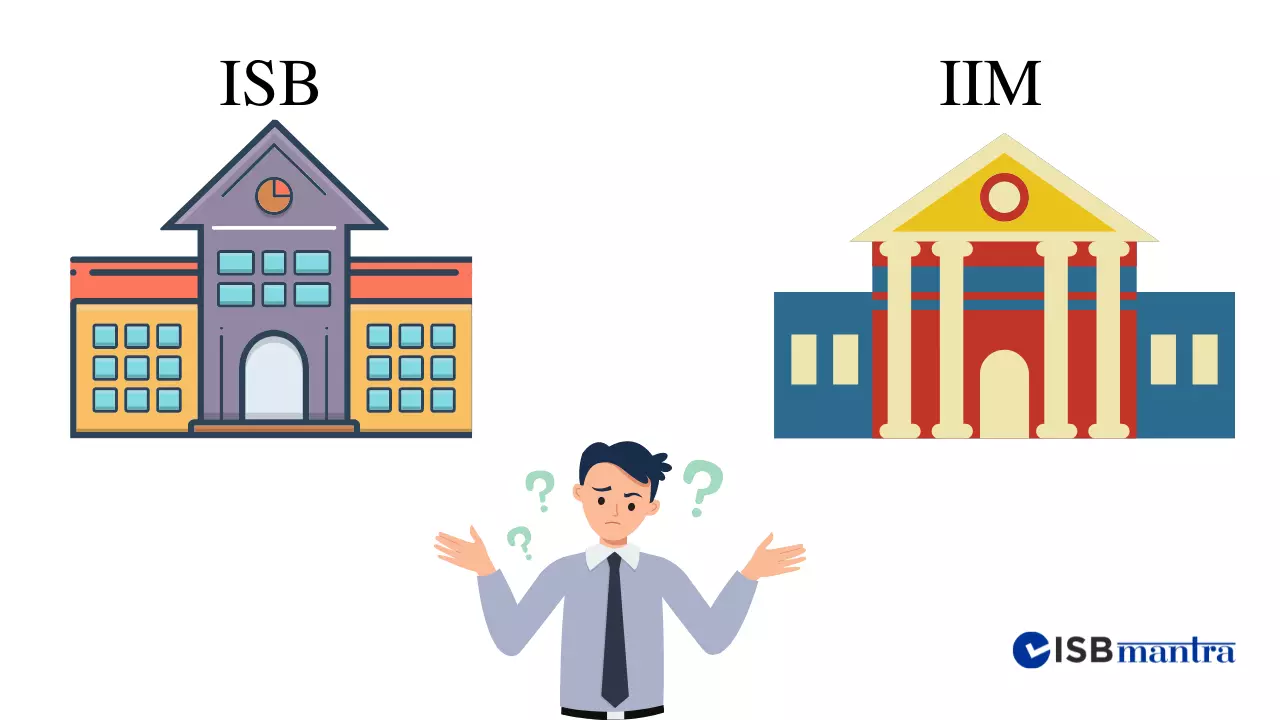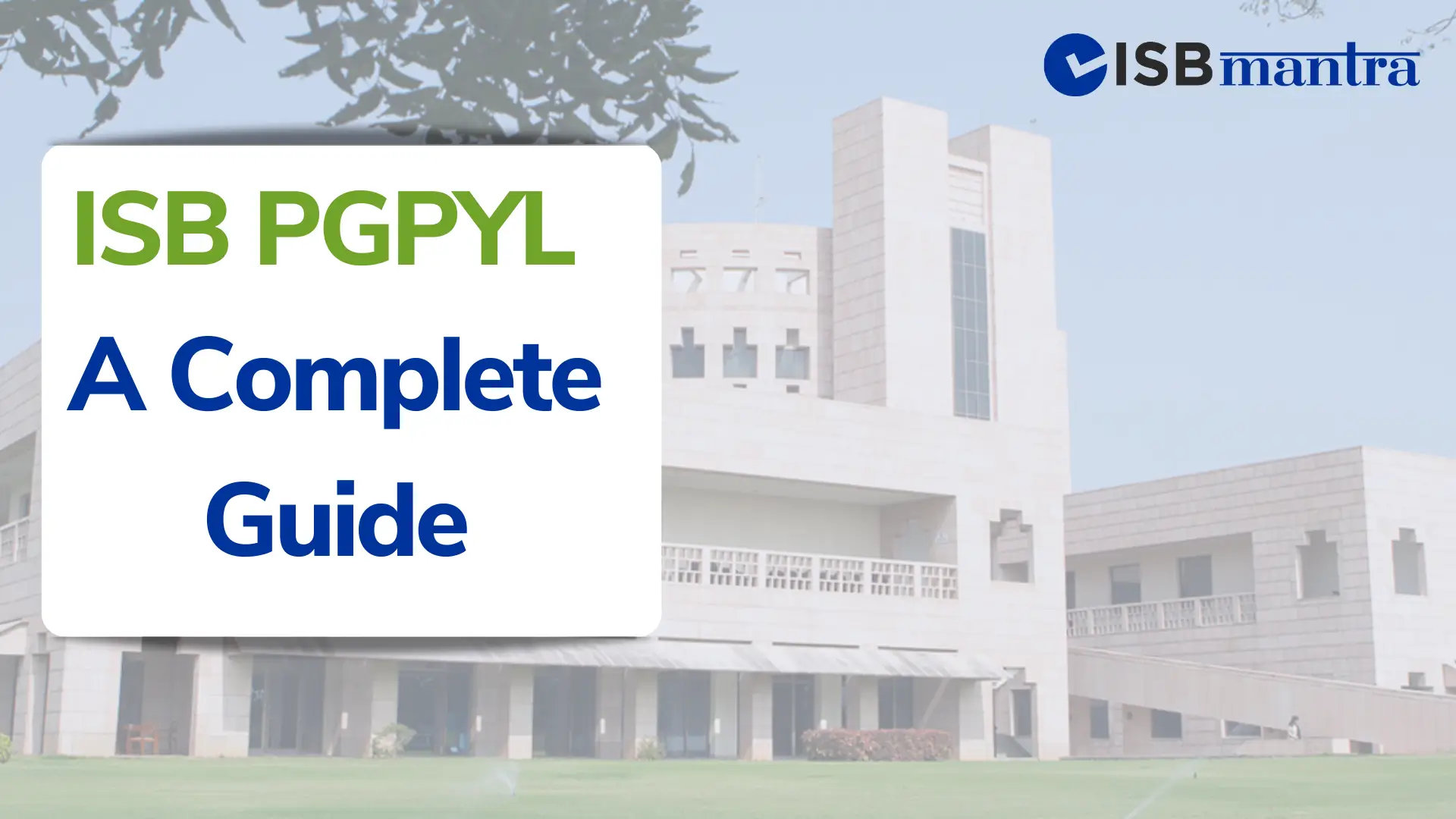The Indian School of Business (ISB) and the Indian Institute of Management (IIM) are the two biggest brands in the business school education market. Both schools have created a trust which is based on decades of experience in imparting business education. Both the schools offer different management programs and therefore, choosing which business school to go to, ISB or IIM becomes a challenging task.

With many options available at ISB and IIM, choosing which MBA program to pursue can be confusing. The goal to pursue an MBA may differ for individuals. You should first be clear on your goal of pursuing an MBA and then analyze the options available. The main components which you should consider are the eligibility criteria, alignment of your goal with the learning outcome of the program, location, duration, cost, and ROI.
Let’s discuss both the schools in detail which will help you decide which is better for you.
ISB was established in 2001 by a group of founders as a world-class business school to inspire young minds and professionals who play a vital role in steering the dynamic business world towards economic growth and social transformation. Whereas, IIM was established much earlier in 1961 to meet the demand for highly skilled managers for the public sector by the Ministry of Education, Government of India.
ISB vs IIM – Location
There are two campuses of ISB in India, Hyderabad, and Mohali. ISB follows the “Two campuses, One school” mantra.
IIM started with locations in Calcutta, Ahmedabad, followed by Bangalore, Lucknow, and more. In the late 2000s, more branches were established to meet the rising demand for management professionals. Now IIMs are located in 20 cities in India.
Though IIMs were started decades before ISB was established, the one-year MBA program at IIM was initiated only in 2006 at IIM Ahmedabad, Bangalore, Calcutta, Indore, Lucknow, and Kozhikode. By then the one-year flagship MBA program (PGP) of ISB had already become the best one-year MBA program.
Before discussing the one-year MBA program, let’s compare the flagship programs of ISB and IIM.
ISB vs IIM – Flagship programs
The flagship program of IIMs is the 2-year MBA (PGP) which primarily targets both freshers and experienced individuals. The flagship program of ISB is the one-year MBA (PGP) which targets only working professionals with more than 2 years of work experience.
Though college students and fresh graduates can get an admit to the PGP program at ISB through YLP and EEO, they can join the PGP class only after gaining the required 24 months of full-time work experience.
The flagship programs at both ISB and IIM are full-time residential programs.
Pursuing an MBA is a personal choice and varies for each person. Before choosing which MBA to pursue it is necessary to understand and analyze the pros and cons of the programs. Both the flagship programs have their own pros and cons.
Let’s discuss the pros and cons of ISB and IIM so that you can decide which business school is a better choice for you, ISB or IIM:
ISB
| Pros of ISB’s one year MBA | Cons of ISB’s one year MBA |
| Strong alumni network | High fees |
| World-class infrastructure | Lower academic immersion due to shorter duration |
| International recognition | Lack of internship |
| Global association | |
| Better networking through professional and social clubs | |
| Larger class size, hence more recruiting companies |
IIM
| Pros of IIM’s two year MBA | Cons of IIM’s two year MBA |
| Experienced peer group | Less exposure to the latest industry skills due to less experienced peer group |
| Internships and International immersions | Smaller alumni base |
| Better peer group networking | Smaller class size, hence fewer recruiting companies |
| More time to explore a career path | |
| Global association |
One major parameter where we can compare ISB and IIM is the year-on-year placement opportunities. Let’s discuss it in detail.
ISB vs IIM – Placements
| Business School | Average salary (LPA) | Number of students | Number of recruiting companies | Total number of offers | Average offer per student |
| ISB | 34.07 | 929 | 270 | 2066 | 2 |
| IIM A | 27.54 | 391 | 131 | 374 | 1 |
| IIM B | 26.18 | 432 | 120 | 518 | 1 |
| IIM C | 28.75 | 444 | 131 | 495 | 1 |
From the data, we can see that ISB offers better placement than IIM. This is primarily because ISB can invite more recruiting companies than IIM due to the bigger class size and a bigger alumni base.
ISB offers good placement opportunities for a shorter program than IIM. Hence, the recovery period of the amount spent for the program would be a year less when you choose to pursue an MBA at ISB. This is applicable only to working professionals.
This is just a general interpretation. Placement is subjective and depends on the abilities of an individual.
If you are a college student or a fresh graduate aiming to pursue an MBA without any work experience, IIM would be a suitable option. As discussed earlier if you are a college student or fresh graduate aspiring to pursue an MBA at ISB, you can apply through the deferred modes of entry. However, you can join the PGP class only after gaining the required 24 months of work experience.
One year MBA programs at ISB and IIM
The one year MBA at ISB and IIM are
ISB (Hyderabad and Mohali): PGP – Post Graduate Programme
IIM Ahmedabad: PGPX – Post Graduate Programme in Management for Executives
IIM Bangalore: EPGP – Executive Post Graduate Programme in Management
IIM Calcutta: MBAEX – MBA for Executives
First, let’s compare these programs and then interpret the details
Comparison of one year MBA program at IIM (A, B, C) and ISB
| ISB PGP | IIMA PGPX | IIMB EPGP | IIMC MBAEx | |
| Type of the program | Full-time residential program | Full-time residential program | Full-time residential program | Full-time residential program |
| Who is it for? | Professionals with minimum 2 years of full-time work experience | Professionals with minimum 4 years of full-time work experience | Professionals with minimum 5 years of full-time work experience | Professionals with minimum 5 years of full-time work experience |
| Global FT MBA Ranking 2021 | 32 | 48 | 35 | 44 |
| Academic qualification | Bachelor’s degree or equivalent | Bachelor’s degree or equivalent | Bachelor’s degree or equivalent | Bachelor’s degree or equivalent |
| Test required | GMAT/GRE | GMAT/GRE | GMAT/GRE | GMAT |
| Average GMAT score | 713 | 701 | 690 | 685 |
| Average CTC | 34.07 lakhs | 26.26 lakhs | 29.88 lakhs | 28.75 lakhs |
| Program fee | 33.14 lakhs | 30 lakhs | 29 lakhs | 27 lakhs |
| Class size | 930 | 140 | 75 | 79 |
| Admission process | -Online application submission (along with essay) -Face to face interview -Final result -Offer acceptance | -Online registration -Online application submission -Essay submission -Personal interview -Final result -Offer acceptance | -Online application submission -Personal interview -Final result -Offer acceptance | -Online application submission -Personal interview -Final result -Offer acceptance |
| Application deadline | Round 1 – September Round 2 – December Round 3 – January | Round 1 – August Round 2 – October Round 3 – December | Round 1 – August Round 2 – October Round 3 – December | Round 1 – August Round 2 – October Round 3 – January |
Let’s dig further by calculating the ROI of the programs at ISB and IIM.
Return On Investment (ROI) of the one year MBA at ISB and IIM
From the above data, we can see that the program fee and average CTC are more or less the same at ISB and IIM. Hence your recovery period will be approximately 2 – 3 years for the money spent for the one-year MBA without a loan and 5 – 6 years for the money paid for the program by taking a loan. This is just an estimation and the recovery time depends on the expense and ability of each individual.
ISB Placements, read this article to know the latest detailed placement report at ISB.
FT Global MBA ranking
Both ISB and IIM rank within the top 50 global MBA schools in the FT ranking. However, ISB ranks better than IIM A, IIM B, and IIM C in the Financial Times (FT) Global MBA ranking.
ISB rankings, check this article to know more about the ISB rankings.
Admission criteria
Getting an admit to the full-time one-year MBA programs at ISB and IIM (A, B, C) depends on the academic credentials, GMAT score, essays, and interview performance. The major difference is in the number of years of working experience. While you can apply to the PGP at ISB if you have a minimum of 2 years of full-time work experience, you can apply to IIM only if you have a minimum of 4 or 5 years of work experience. This infers that both the schools have different audiences and there is no winner here.
Admission can be easy or tough at ISB and IIM, which depends on your profile, leadership quality, communication skills, work experience, goal alignment with learning outcome and contribution to the class.
Class size
The class size of ISB PGP is much larger (around 900) compared to the class size of IIM A’s PGPx (around 140), IIM B’s EPGP (around 80), and IIM C’s MBAEX (around 80). This explains the diversity of the class.
While pursuing an MBA, student networking is one of the top priorities. The wider the network the better are your learning opportunities.
Check this article to understand about the class diversity of ISB, Diversity at ISB.
Networking is also essential after completing an MBA. This is where the alumni network plays its role. ISB has a much stronger alumni network due to its bigger class size.
ISB Alumni Network, check this article to know the strength of ISB alumni network.
As mentioned earlier each person has a different objective to pursue an MBA. Each factor in the comparison of programs varies for each individual. It is better to make a decision based on your goals, learning outcomes, cost, location, and duration of the program.
ISB Application and Interview Services
We at ISBmantra with a team of former ISB admissions officers and 25 + alums can guide you through the application and interview process.
Sign up now for free.




Comments are closed.